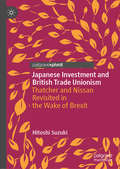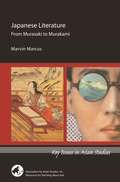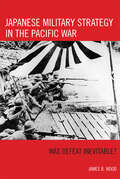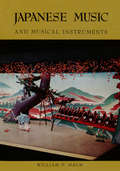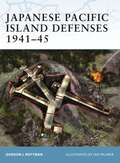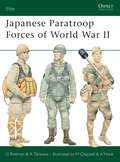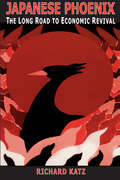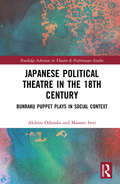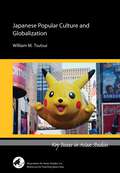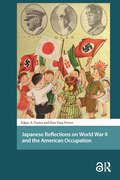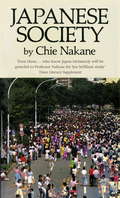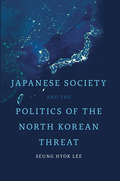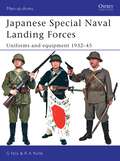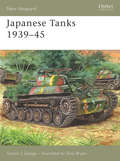- Table View
- List View
Japanese Inn
by Oliver StatlerThe history of Minaguchi-ya, a Japanese inn, from its unintentional inception in 1569 to a visit from the Emperor and Empress in 1957.
Japanese Inn: A Reconstruction Of The Past
by Oliver StatlerThe beguiling story of the Minaguchi-ya, an ancient inn on the Tokaido Road, founded on the eve of the establishment of the Tokugawa shogunate. Travellers and guests flow into and past the inn -- warriors on the march, lovers fleeing to a new life, pilgrims on their merry expeditions, great men going to and from the capital. The story of the Minaguchi-ya is a social history of Japan through 400 years, a ringside seat to some of the most stirring events of a stirring period.'Statler has created a strangely beautiful book that succeeds in conveying intact not only a great deal of its history but the mood of that land. The result is sheer delight. Japanese Inn is the work of a master craftsman; it is so well conceived that the narrative moves from past to present in the same paragraph without the slightest confusion to the reader; it is so well written that only in retrospect is one aware of its remarkable flawless style. Through the author's particular magic, the stories unfold as one narrative, as beautifully and memorably as the unrolling of a long Japanese scroll.'--CURT GENTRY'The reader learns much of Japan's past -- and, as is inevitable in a study of that country, of present-day Japanese as well. Mr Statler's prose succeeds in evoking the pageantry of the past in the brilliant color of the kabuki stage. Nothing seems to have been overlooked by the author. Mr Statler's book is Japanese history made easy, and grand entertainment.'-- NEW YORK TIMES BOOK REVIEW'Much of it is told in fictional form. Some of the episodes have come out of family annals and memories, some from the records of the temple; some are imagined; but all could have happened ... Mr Statler has told the story vividly and with sympathy. It moves. It has the authentic feel of Japan.'--INTERNATIONAL HERALD TRIBUNE
Japanese Investment and British Trade Unionism: Thatcher and Nissan Revisited in the Wake of Brexit (New Directions in East Asian History)
by Hitoshi SuzukiThis book revisits the long contested negotiation between the Thatcher administration and Nissan for the latter's first green-field plant in Europe. From the very beginning, the plant took Britain’s EC/EU membership and tariff-free access to the single market as a token. A considerable amount of aid including component supplies was provided to attract Japanese investment and to prevent its transfer to the continent. The successful launch of Sunderland highlighted improved Anglo-Japanese relations and put an end to the Japan-EC/EU trade conflict. But the price was paid by Nissan’s slump and fall, and by trade unions in both countries failing to keep counterchecks on management. Brexit and the fall of Carlos Ghosn were a double blow to Anglo-Japanese relations which are in a state of drift and need redefinition.
Japanese Literature: From Murasaki To Murakami (Key Issues In Asian Studies)
by Marvin MarcusJapanese Literature: From Murasaki to Murakami provides a concise introduction to the literature of Japan that traces its origins in the seventh century and explores a literary legacy—and its cultural contexts—marked by the intersection of aristocratic elegance and warrior austerity. Coverage extends to the present day with a focus on the complex twists and turns that mark Japan’s literature in the modern period. In under one-hundred pages of narrative, Marcus’s account of Japanese literature ranges from the 712 CE publication of Japan’s first literary work, the Kojiki, to internationally-famous 21st century authors. Readers get a sense of past and contemporary literary themes and well written vignettes of the men and women who produced works that are an integral part of Japan’s literary traditions. Readers are introduced to Japanese literature, but Marcus’s linkages to history and culture increase the likelihood that many readers will be inspired to learn more about Japan and its rich history. Marcus’s compelling interpretations of significant works of Japanese literature and their historical moments complement carefully selected passages of literary prose, poetry, and images from Japan's long literary and cultural history. This small gem of a book is essential for students, teachers, and general audiences interested in Japan and its long literary traditions.
Japanese Love Hotels: A Cultural History (Routledge Contemporary Japan Series #Vol. 15)
by Sarah ChaplinDrawing on theories of place, consumption and identity, Sarah Chaplin details the evolution of the love hotel in urban Japan since the 1950s. Love hotels emerged in the late 1950s following a ban of licensed prostitution, then were extremely popular in the 1970s, were then legislated against in the 1980s and are now perceived as ‘leisure’, ‘fashion’ or ‘boutique’ hotels. Representing a timely opportunity to capture and evaluate the dying manifestations of an important era in Japanese social and cultural history, this book provides a critical account of the love hotel as a unique typology. It considers its spatial, aesthetic, semiotic, and locational denotations and connotations, which results in a richly nuanced cultural reading. The love hotel is presented as a key indicator of social and cultural change in post-war Japan, and as such this book will be of interest to a wide and international readership including students of Japanese culture, society and architecture.
Japanese Military Strategy in the Pacific War: Was Defeat Inevitable?
by James B WoodIn this provocative history, James B. Wood challenges the received wisdom that Japan's defeat in the Pacific was historically inevitable. He argues instead that it was only when the Japanese military prematurely abandoned its original sound strategic plan—to secure the resources Japan needed and establish a viable defensible perimeter for the Empire—that the Allies were able to regain the initiative and lock Japanese forces into a war of attrition they were not prepared to fight. The book persuasively shows how the Japanese army and navy had both the opportunity and the capability to have fought a different and more successful war in the Pacific that could have influenced the course and outcome of World War II. It is therefore a study both of Japanese defeat and of what was needed to achieve a potential Japanese victory, or at the very least, to avoid total ruin. Wood's argument does not depend on signal individual historical events or dramatic accidents. Instead it examines how familiar events could have b
Japanese Music and Musical Instruments
by William P. MalmMr. Malm makes available in this interesting and authoritative book the essential facts about the various forms of Japanese music and musical instruments and their place in the overall history of Japan. The book has three main orientations: the history of Japanese music, construction of the instruments, and analysis of the music itself. The book covers in a lucidly written text and a wealth of fascinating photographs and drawings the main forms of musical expression. Many readers will find the useful hints on purchasing instruments, records, and books especially valuable, and for those who wish to pursue the matter further there is a selected bibliography and a guide to Tokyo's somewhat hidden world of Japanese music. It will be found an invaluable aid to the understanding and appreciation of an important, but little-known, and fascinating aspect of Japanese culture.
Japanese Naval Air Force Fighter Units and Their Aces, 1932–1945
by Christopher Shores Yasuho Izawa Ikuhiko HataAn extensive guide to Japan&’s Naval Air Force Fighter Units and their ace pilots during conflicts in the 1930s and &‘40s, now in English. The book begins by looking at the land- and aircraft carrier-based navy fighter units and their operations from 1932 to 1945, as well as their history and achievements. This is followed with biographical details for all pilots who claimed eight or more aerial victories. The thorough appendix provides detailed listings of all pilots known to have claimed five or more victories (and thus considered to be &“aces&”), listings of the graduation from training of all Japanese Navy fighter pilots, and of fighter pilot casualties. Photographs, maps, and artist&’s side-view drawings and paintings of aircraft relevant to each of the units are also included. This revised edition is a companion volume to Japanese Army Air Force Fighter Units and Their Aces, 1931–1945.
Japanese Naval Aviation Uniforms and Equipment 1937#45
by Gary Nila Bill YounghusbandThis long awaited title provides a fantastic reference resource on the uniforms, dress, flight gear and personal weaponry of the Imperial Japanese Navy airmen of World War II (1939-1945). It includes detailed descriptions of flight gear, including manufacture information, and interviews with IJN pilots such as Sakai, Komachi, Tanimizu, Kawato and Saito regarding the use of a variety of equipment are integrated into the text. Packed with great contemporary illustrations, photographs of original items, and colour pictures, this title provides a meticulously detailed examination of the dress and equipment of the Imperial Japanese Navy's aviators in World War II.
Japanese Notebooks: A Journey to the Empire of Signs
by IgortJapan is a place of special fascination for the acclaimed international comics creator Igort, who has visited and lived there more than 20 times, and worked in the country's manga industry for more than a decade. In this masterful new book—part graphic memoir, part cultural meditation—Igort vividly recounts his personal experiences in Japan, creating comics amid the activities of everyday life, and finding inspiration everywhere: in nature, history, custom, art, and encounters with creators including animation visionary Hayao Miyazaki. With beautifully illustrated reflections on subjects from printmaking to Zen Buddhism, imperial history to the samurai code, Japanese film, literature, and manga, this is a richly rewarding book for anyone interested in Japan or comic arts practiced at the highest level.
Japanese Pacific Island Defenses 1941-45
by Gordon Rottman Ian PalmerThe prolonged and bloody fighting for control of the Japanese occupied Pacific islands in World War II is a key point in 20th-century warfare. No two islands were alike in the systems and nature of their defensive emplacements, and local improvization and command preferences affected both materials used and defensive models. This title details the establishment, construction and effectiveness of Japanese temporary and semi-permanent crew-served weapons positions and individual and small-unit fighting positions. Integrated obstacles and minefields, camouflage and the changing defensive principles are also covered.
Japanese Paratroop Forces of World War II
by Gordon Rottman Mike ChappellOsprey's examination of Japan's parachute units of World War II (1939-1945). For the first time in English, this book offers a concise but fact-packed account of the organization, equipment, and all operations of Japan's small but elite wartime parachute forces. Correcting and amplifying previous accounts based on wartime intelligence, it traces the Imperial Army's Raiding Regiments and the Imperial Navy's parachute-trained Yokosuka 1st & 3rd Special Naval Landing Forces from the first trials units, through their successful assaults in early 1942, to the last desperate battles and raids of 1944-45. The text is illustrated with rare photographs, and meticulously reconstructed color artwork of the men and their gear.
Japanese Perspectives on Kazuo Ishiguro
by Takayuki Shonaka Takahiro Mimura Shinya MorikawaThis collection of essays offers new perspectives from Japan on Nobel Prize–winning author Kazuo Ishiguro. It analyses the Japanese-born British author from the vantage point of his birthplace, showing how Ishiguro remains greatly indebted to Japanese culture and sensibilities. The influence of Japanese literature and film is evident in Ishiguro’s early novels as he deals with the problem of the atomic bomb and Japan’s war responsibility, yet his later works also engage with folk tales and the modern popular culture of Japan. The chapters consider a range of Japanese influences on Ishiguro and adaptations of Ishiguro’s work, including literary, cinematic and animated representations. The book makes use of newly archived drafts of Ishiguro’s manuscripts at the Harry Ransom Center at the University of Texas to explore the origins of his oeuvre. It also offers sharp, new examinations of Ishiguro’s work in relation to memory studies, especially in relation to Japan.
Japanese Phoenix: The Long Road to Economic Revival
by Richard KatzJapan will recover and its economic achievements will once again earn the world's admiration, with sustained annual growth of three percent, perhaps more, well within reach. This is the confident forecast that begins Japanese Phoenix: The Long Road to Economic Revival by the author of Japan: The System That Soured, which several years ago accurately predicted Japan's current travails at a time when others were prematurely pronouncing full recovery. Katz warns however that there is bad news to go with the good. So deep-seated are Japan's dysfunctions that, even if it did everything right today, it would take at least five years for truly vibrant growth to take hold. But Japan will not do everything right. Opposition to reform is deep-seated and a myriad of vested interests and millions of jobs are at stake. Still he notes, there is little doubt that reform will succeed. Japanese Phoenix tells the story of the struggle between the forces of reform and the forces of resistance. It dissects Prime Minister Koizumi's role in the process, and explains why Japan is in so much trouble and what needs to be done. It explore the debates among economists and gives a careful progress report on all the moves made so far in the name of reform - from greater direct foreign investment, to the financial "Big Bang", to ending one-party rule by the Liberal Democratic Party. Katz concludes that this is just the second round of a 15-round fight. Japan is a great nation currently trapped in obsolete institutions. As it has before, Japan will find a way to surmount its problems and regain its forward progress.
Japanese Poetry and its Publics: From Colonial Taiwan to Fukushima (Postcolonial Politics)
by Dean Anthony BrinkThis book aims to explore precisely how modern Japanese poetry has remained central to public life in both Japan and its former colony of Taiwan. Though classical Japanese poetry has captivated the imagination of Asian studies scholars, little research has been conducted to explore its role in public life as a discourse influential in defining both the modern Japanese empire and contemporary postcolonial negotiations of identity. This book shows how highly visible poetry in regular newspaper columns and blogs have in various historical situations in Japan and colonial Taiwan contested as well as promoted diverse colonial imaginaries. This poetry reflects both contemporary life and traditional poetics with few counterpoints in Western media. Methodologically, this book offers a defense of the public influence of poetry, each chapter enlisting a wide range of social and media theorists from Japan, Europe, and North America to explore specific historical moments in an original recasting of intertextuality as a vital feature of active inter-evental material engagements. In this book, rather than recite a standard survey of literary movements and key poets, the approach taken is to examine uses of poetry shown not only to support colonialism and imperialism, emerging objectionable forms of exploitation as well as the destruction of ecologies (including old-growth forests in Taiwan and the Fukushima Disaster), but also to present a medium of resistance, a minor literature for registering protest, forming transnational affiliations, and promoting grass-roots democracy. The book is based on years of research and fieldwork partially in conjunction with the production of a documentary film, Horizons of the Rising Sun: Postcolonial Nostalgia and Politics in the Taiwan Tanka Association Today (2017).
Japanese Political Theatre in the 18th Century: Bunraku Puppet Plays in Social Context (Routledge Advances in Theatre & Performance Studies)
by Akihiro Odanaka Masami IwaiBunraku has fascinated theatre practitioners through its particular forms of staging, such as highly elaborated manipulation of puppets and exquisite coordination of chanters and shamisen players. However, Bunraku lacks scholarship dedicated to translating not only the language but also cultural barriers of this work. In this book, Odanaka and Iwai tackle the wealth of bunraku plays underrepresented in English through rexamining their siginifcance on a global scale. Little is written on the fact that bunraku theatre, despites its elegant figures of puppets and exotic stories, was often made as a place to manifest the political concerns of playwrights in the 18th century, hence a reflection of the audience's expectation that could not have materialized outside the theatre. Japanese Political Theatre in the 18th Century aims to make bunraku texts readable for those who are interested in the political and cultural implications of this revered theatre tradition.
Japanese Popular Culture and Globalization (Key Issues in Asian Studies)
by William M. TsutsuiJapanese Popular Culture and Globalization is the only concise overview of Japan’s phenomenal impact on world pop culture available in English. Surveying Japanese forms from anime (animation) and manga (comic books) to monster movies and Hello Kitty products, this volume is an accessible introduction to Japan’s pop creativity and its appeal worldwide. Written in an accessible style and illustrated with more than 20 photographs, Japanese Popular Culture and Globalization combines a historical approach to the evolution and diffusion of Japanese pop with interdisciplinary perspectives from anthropology, literary studies, political science, and the visual arts. It also includes a useful glossary of terms and a bibliography of recommended readings.
Japanese Portraits
by Donald RichieThe private collections of longtime Japan resident Donald Richie capture the personalities of certain Japanese people--some famous, some unknown--with insight and humor. Richie, who considers himself a foreigner despite living in Japan for over 53 years, is a keen observer of human nature. In Japanese Portraits, he provides an elegant and perceptive vision of Japan through precise, intimate portraits of ordinary and extraordinary Japanese people. Portraits include such notable Japanese as acclaimed filmmakers Akira Kurowasa and Yasujiro Ozu, famed novelist Yukio Mishima, and celebrated actor Toshiro Mifune.
Japanese Reflections on World War II and the American Occupation (Asian History)
by Edgar Porter Ran Ying PorterThis book presents an unforgettable up-close account of the effects of World War II and the subsequent American occupation on Oita prefecture, through firsthand accounts from more than forty Japanese men and women who lived there. The interviewees include students, housewives, nurses, midwives, teachers, journalists, soldiers, sailors, Kamikaze pilots, and munitions factory workers. Their stories range from early, spirited support for the war through the devastating losses of friends and family members to air raids and into periods of hunger and fear of the American occupiers. The personal accounts are buttressed by archival materials; the result is an unprecedented picture of the war as experienced in a single region of Japan.
Japanese Society
by Chie NakaneWhy do the Japanese almost always go for holidays in groups? Do Japanese families experience our sort of 'family life'? Why do conversations with Japanese friends and acquaintances often seem to come to an abrupt halt just when they're getting interesting - that is, a little controversial? What motivates the Japanese man in the street? Professor Nakane, writing with an intimate knowledge of her own people, provides in this fascinating book the answers to these and many other perplexing questions. Using the structure of Japanese society as the basis of her analysis, rather than explaining it in cultural or historical terms, Professor Nakane begins by examining one-to-one relationships, following through to the structure of the group and finally that of the society as a whole.
Japanese Society (Center For Japanese Studies, Uc Berkeley Ser. #4)
by Chie NakaneWhy do the Japanese almost always go for holidays in groups? Do Japanese families experience our sort of 'family life'? Why do conversations with Japanese friends and acquaintances often seem to come to an abrupt halt just when they're getting interesting - that is, a little controversial? What motivates the Japanese man in the street? Professor Nakane, writing with an intimate knowledge of her own people, provides in this fascinating book the answers to these and many other perplexing questions. Using the structure of Japanese society as the basis of her analysis, rather than explaining it in cultural or historical terms, Professor Nakane begins by examining one-to-one relationships, following through to the structure of the group and finally that of the society as a whole.
Japanese Society and the Politics of the North Korean Threat
by Seung Hyok LeeIn 1998 and in 2006, North Korea conducted ballistic missile tests that landed dangerously close to Japan. In the first case, the North Korean tests provoked only Japanese alarm and severely constrained action. In the second, the tests led to unilateral economic sanctions - the first time since the end of the Second World War that Japan has used coercion against a neighboring state. What explains this dramatic shift in policy choice?Seung Hyok Lee argues that the 2006 sanctions were not a strategic response to the missile tests, but a reflection of changing public attitudes towards North Korea - the result of the shocking revelation that the North Koreans had abducted at least seventeen Japanese citizens in the 1970s and 80s and secretly held them prisoner for decades. Japanese Society and the Politics of the North Korean Threat is the first book on this development in English and a valuable case study of public opinion's increasing influence on Japanese security policy.
Japanese Special Naval Landing Forces
by Christa Hook Gary NilaThe spearhead of Japan's assault landing operations both in China pre-Pearl Harbor, and in US and British territory post-Pearl Harbor, was provided by the Special Naval Landing Forces - 12 numbered battalion-size Imperial Japanese Navy units. They garrisoned a number of the islands which the US Marines then had to re-claim in some of the bloodiest battles of the Pacific War of World War II (1939-1945). These included the infamous battles of Iwo Jima and Okinawa. This book provides a comprehensive treatment of the elite force which has never before been examined in such detail in English, covering weapons and equipment as well as uniform and insignia.From the Trade Paperback edition.
Japanese Swords
by Colin M. Roach Nicklaus Suino"Tracks the fundamental transition from the sword as a mythological instrument to a functional tool for war, and finally to the display art commodity it is today." - Publishers WeeklyAuthor Colin M. Roach collaborated with top-level artisans, historians, and martial arts experts to create a unique, in-depth study of these magnificent weapons from a historical, iconographical, and technological perspective. In addition to a foreword by seventh degree iaido black belt Nicklaus Suino and a sidebar by Mukansa-level polisher Abe Kazunori, Japanese Swords includes rare looks into the world of Mukansa-level swordsmiths Kawachi Kunihira and Gassan Sadatoshi. Complemented by hundreds of stunning high-resolution photos and downloadable material, Japanese Swords is a must-have addition to any Japanophile's library.
Japanese Tanks 1939-45
by Steven Zaloga Peter BullContrary to popular belief, the Japanese Army widely employed tanks within the Pacific theater of war. This title details their key role in the conquests of Singapore and Malaya, as well as their later use in Burma, Saipan, and the Philippines, including in the amphibious assault of Corregidor. Tank development succeeded against the odds, with the programme often neglected to pursue the higher priority of warship development. Their use in the most difficult of terrain is a testament to their ingenuity.Steven J Zaloga's book offers a rare insight into a largely overlooked subject and is rich with photographs and artwork, providing a wonderful resource for the construction and design of these fascinating tanks.From the Trade Paperback edition.


